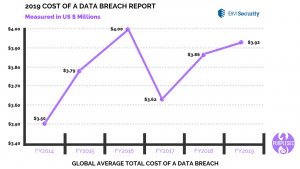Threat intelligence is construed as a technology of novelty, something deemed an efficient tool to detect, analyze, and neutralize security threats. The mere presence of it reinforces a security system against potential vulnerabilities, thus assisting an organization’s data security teams to act proactively to identify security risks and eliminate threats. The imperativeness of this technology is such that jeopardizing a company’s valuable data would be a sure outcome if its application is put into question.
We understand that the contribution made by innovative technologies like artificial intelligence and machine learning etc. to the world’s economic and cultural institutions is substantial.
However, they have also given rise to threats like cyberattacks from countless unauthorized sources floating across the digital sphere. These threats, quite understandably, pose a greater risk to cybersecurity.

The Rise of Cyber Threats
Reportedly, the COVID-19 pandemic has also witnessed an upsurge in cybercrime by 600%, besides wreaking havoc on human lives and the economy of nations worldwide. Emails of imposters claiming to represent the World Health Organization (WHO) or CDC (the Center for Disease Control and Prevention) tantalize the recipients to click an attachment/link containing the malicious virus. These threats are deceptively dangerous in undermining the core of an organization’s security system unless an efficient reinforcement of cyber threat intelligence is put in place.
Threat intelligence is said to be an effective technique against network security vulnerabilities or cyber threats by mitigating unauthorized access/attacks and helping you to make informed decisions regarding security. If used smartly, the technology can decode the deceptivity of any cyber threat masquerading as friendly in a host system.
Hence, cyber threat intelligence has its profound importance for organizations, as explained further.
What is the importance of threat intelligence?
The inundation of countless data and their effective protection from authorized access has piled pressure on cyber experts to devise the most strategically innovative steps to make sure uncompromised protection of valuable data against cyber threats. The challenges associated with tackling cyber threats effectively such as managing extraneous and ambiguously structured data, regular inflow of massive data, hoax alerts across diverse, unconnected security systems, and so on and so forth.
Organizations lacking technical know-how of how to deal with data surfeit end up making the job of their in-house analysts painfully difficult to understand what to prioritize and what to ignore. Cyber threat intelligence, on the other hand, provides an effective solution to these issues, by leveraging the power of machine learning which facilitates automation of data collection and processing.
Besides, the solution also involves compiling unstructured data from diverse sources and connecting the dots after yielding the context on indicators of compromise (IoCs) and procedures related to threat factors.
Cyber threat intelligence involves:
- Gathering human and technical information globally.
- Providing contextual, adversary-focused data.
- Helping organizations to proactively gear up for cyber threats.
- Providing detailed insights about threats and the likelihood of them affecting an organization to ensure a preventive measure accordingly.
- Helping organizations how to respond to real threats by prioritizing alerts. This precludes the risk of a costly data breach.
- Helping organizations to make informed decisions on aligning security expenditure in conformity with their requirements.
Threat intelligence holds its importance, in terms of being timely, providing context, and easily understandable to the decision-makers.
To whom does threat intelligence mean beneficial?
The benefit of threat intelligence is not limited to a particular individual or industry. Believed to be the domain of elite analysts, the value provided by threat intelligence covers diverse security functions for companies, irrespective of size.
Teams handling security operations can’t always process the incoming alerts. With threat intelligence, the teams can automatically prioritize and filter threat alerts, after integrating TI with the security solutions they already use. Besides, threat intelligence is also helpful for vulnerability management teams by providing them with external insights and context with which they can identify key vulnerabilities more accurately.
Moreover, threat intelligence facilitates a better understanding of key threat areas by enriching fraud prevention, risk analysis, and different sorts of security processes.

The lifecycle involved in threat intelligence:
Devising plans and goals
When it comes to creating actionable threat intelligence, asking the right question, and analyzing how your intelligence goals resonate with your company’s core values are important considerations.
Gathering raw data
This step involves the collection of data from multiple sources, both internal and external ones (internal sources involve network event logs and records of past incident responses while external sources involve the open web, the dark web, and technical sources).
Processing
It involves sorting the collected data, organizing the same with metadata tags, and ensuring superfluous data is filtered out.
Analysis
It ensures that the processed data reveals sense like identifying potential security issues and informing the concerned authority in a way that suits the intelligence requirements defined in the planning and direction stage.
Distribution
This stage involves the timely distribution of the product to the right people.
Feedback
This is the last step signaling the intelligence cycle coming full circle. At this stage, the intelligence becomes very much related to the initial planning and direction phase. The team in charge of making the “initial request” analyzes the finished intelligence product to see if their questions were answered. When done, it sets in motion the procedures and objectives of the next intelligence cycle.
Difference between threat intelligence and threat information
The mechanism permitting the functionality of threat intelligence is based on the collected data revealing potential threats. Does that mean threat intelligence is just a revelation of threat data? Not at all. It’s beyond that. For threat intelligence to be able to work effectively, it depends on the efficacy of contextual data and its correlation with the threat information.
The contextual data stands for the first appearance of a flagged threat and its influence on a victim organization.
To be followed right after is the meticulous analysis of an expert cybersecurity professional regarding threat information. It leads to conclusive insight revealing the potential nature of the threat detected and remedial measures against it, together with ensuring that organizations are armed with actionable tips to neutralize the security vulnerabilities using the Indicators Of Compromise tactic.
What are the Indicators of Compromise?
IOC (Indicators of Compromise) refers to the forensic data either detected in a computer system’s log entries or files, bearing a warning sign of a potential data breach on a system/network. Once identified, an organization can proactively devise necessary steps augmenting the chance to neutralize data threats. The indicators of compromise include
- Suspicious IP address, URLs, or websites infected with malware.
- Email attachments, email IDs, or email subject/link driving the recipient to fall for phishing attempts.
- DLLs, filenames, registry keys, or file hashes infected with a potentially nefarious threat.
Types Of Threat Intelligence
- Strategic threat intelligence – it provides insights regarding security risks pertaining to the threat landscape, along with preventive measures, threat goals, and the severity of the attack, etc.
- Tactical threat intelligence – future-focused and helps teams to conclude the efficacy of current security programs in detection and neutralization of threats based on the highlighted IOCs.
- Technical threat intelligence – it concludes a baseline for analyzing attacks through specific clues or evidence of their preliminary occurrence.
- Operational threat intelligence – it provides insights into several factors (nature, motive, modus-operandi) of attacks to form a compact knowledge base related to security breaches.
With cybersecurity threats rising unabated from all around the world, companies/organizations deem involvement of threat intelligence as an imperative tactic to efficiently and effectively address security risks, vulnerabilities, and neutralize them proactively.
